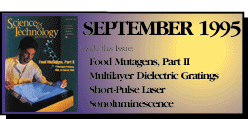 September 1995 in PDF format (5583K)
September 1995 in PDF format (5583K)
 September 1995 in PDF format (5583K)
September 1995 in PDF format (5583K)
Heterocyclic amines are potent mutagens, and they are carcinogenic in laboratory animals. We have shown that typical Western diets rich in well-done meat cooked at high temperatures have significant levels of at least five different heterocyclic amines. We are beginning to understand the process by which food mutagens become adducted to DNA. This molecular binding to DNA is an important step that can lead to cancer. The binding of mutagens depends on the formation of intermediate, biologically reactive molecules. The intermediates appear to link preferentially to the DNA base guanine. The extent of DNA adduction and the subsequent occurrence of tumors vary considerably in different types of tissues, such as the liver and pancreas, and in different animal species.
A comparison of fried meats shows that beef and chicken are the most mutagenic types of food in a typical Western diet. When account is taken of the relative amounts of different meats consumed by Americans and of the potency of mutagens in them, ground beef may be the most important source of food mutagens in the U.S. diet. The overall, average, upper-bound estimate of cancer risk in the U.S. from eating heterocyclic amines in cooked foods is about one in ten thousand. The consumption of meat and chicken contributes most to the total risk. Some individuals eating large amounts of well-done muscle foods may be at much greater risk.
High-power, short-pulse laser systems are vital to continuing inertial confinement fusion research. We have completed a system that can produce 100 terawatts (100 trillion watts) of pulsed power lasting about a trillionth of a second and will soon complete another system that will produce a petawatt (a quadrillion watts, or 1015 W) of power in a similarly short pulse.
High-power lasers present a special problem, however. As amplifiers increase the energy of the beam, the laser pulse intensity drives nonlinear changes in the refractive index of the amplifier material, causing the beam to self-focus and damage the amplifier. To avoid this effect, a pair of gratings is used to stretch the pulse and lower its peak intensity. The stretched or "chirped" pulse is then amplified many thousands of times and is finally passed through a second grating pair that compresses the pulse, shortening it almost to its original duration. When the laser pulse strikes its target, it is at its power-amplified, time-compressed peak intensity.
Traditionally, diffraction gratings have been made of metal-gold, silver, or aluminum. However, because electrical conductivity in the skin of the metal is the basis of their reflectivity, they are susceptible to optical damage. Multilayer dielectric gratings, by contrast, are made of transparent, insulating materials. They are reflective through interference from many layers and distribute the reflection through the bulk of the material. They are thus not easily subject to optical damage and can be used in carefully constructed pairs to first stretch and then compress the short, high-energy pulses of today's most powerful lasers.
 and LLNL Disclaimers
and LLNL Disclaimers
UCRL-52000